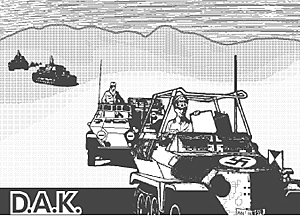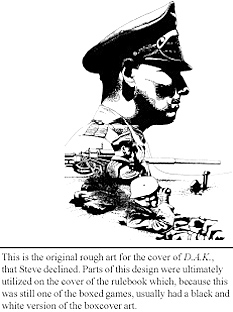 D.A.K. is a two player game-type simulation of the events of the Second World War in the North African Theatre.
D.A.K. is a two player game-type simulation of the events of the Second World War in the North African Theatre.
Players 2
Period WWII North Africa, September 1940 - May 1943
Scale Strategic Turn 11 quarterly turns
Map 65 kilometers per hex
Units Regimental, with some battalions
Components
Box cardboard or ziploc
Map 22"x28", unmounted, thick paper
Rules 16 page 6"x9"
Counters 200 die-cut and backprinted
Counter Manifest
62 British (red)
40 Italian [tan]
36 German [brown]
14 American [green]
10 French [blue]
2 Spanish [white]
30 port status markers [gray / pink]
6 randomizer chits [white]
1 turn marker [green]
SimCan says:
“D.A.K. examines the entire North African campaign…The map runs from Damascus to Safi and the action from the first Italian offensive to the final Axis collapse. It has often been called the Quartermaster’s War, and this is not far from wrong. With D.A.K., I wanted to show this aspect with all its limitations while still maintaining a viewpoint for the players as overall theatre commanders. About 6-8 hours is the normal playing time.”
The Reviewer says:
“Every North Africa game requires logistics constraints, but the bookkeeping really cuts into D.A.K. The key to understanding and playing D.A.K. is ‘Ops Points’. You have to plan pretty much what you want to do in a turn right from the beginning…The supply system does accurately portray the limitations under which theater commanders operated. D.A.K. has a few bright spots, but struggles in an attempt to simulate strategically what was mainly an operational theater.” --Jay C. Selover in F&M 38.
Comments
Amidst a plethora of other North Africa games, D.A.K. actually generated a fair amount of interest for me. Yes, one will need a calculator, as there is a lot of number tracking here. However, SimCan was thoughtful enough to include an ‘easy’ version that eliminates much of the logistical concerns and thus makes the game more playable. Rules cover replacements and withdrawals, air points, individually rated ports, supply dumps, garrisons, combat modifiers (mech, combined arms, German 88’s, etc.), leaders, oases, and much more. Combat units are rated for strength and efficiency.
The strange map is designed to be cut in half to lay lengthwise, but this is not really necessary as you can easily walk units over to the other map when they exit one edge.
Intended to link up with the La Regia Marina naval design, this still is a decent looking stand-alone item, though it does appear that it would really shine when mated up with L.R.M.
 Collectors Notes
Collectors Notes
This title is fairly common, and usually does not command a high price. Boone lists low, high and average prices of 4/17/8.75 at auction and 3/25/13.30 for sale.
Errata & Clarifications
- All airfields and major airfield hexes are considered to be cities for terrain effects purposes.
- Units with blank boxes as unit symbols are garrisons.
- A unit can pass through an enemy-occupied hex without overrunning. Originally the 7.335 disengagement rule was to apply but the playtesters didn’t like keeping track of which enemy units had been screened.
- The overrun rule stating that the overrun must be declared before paying the extra Op Points to enter should be deleted. There are no extra costs to overrun.
- The Ops Point chart on the map is incorrect.
Stephen Newberg says:
There were so many strategic North Africa games, and so many were so historically poor, that we could not resist giving it a try. As the group goes, D.A.K. is not bad. With the historical actions you can actually produce the historical out comes. That alone is a plus for games on this topic. The counter mix is very condensed, leading to short games. The operations points system seems to keep players from doing impossible things. And you can mate it up to La Regia Marina to play the entire Mediterranean theater.
Back to Simulacrum Vol. 3 No. 2 Table of Contents
Back to Simulacrum List of Issues
Back to MagWeb Master Magazine List
© Copyright 2001 by Steambubble Graphics
This article appears in MagWeb (Magazine Web) on the Internet World Wide Web. Other military history articles and gaming articles are available at http://www.magweb.com